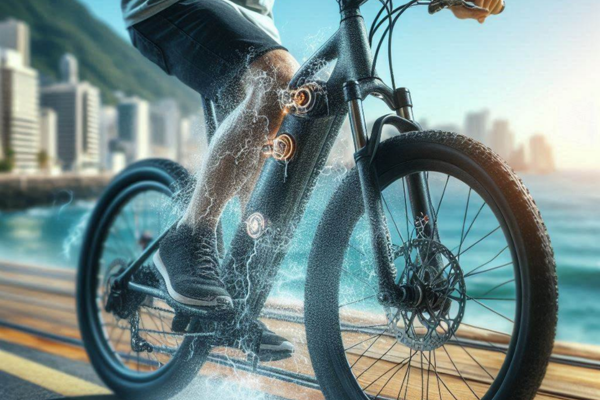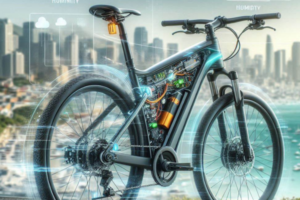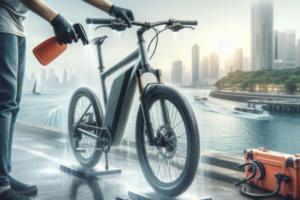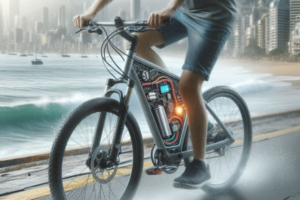🌫️ The Hidden Influence of Humidity on Your E-Bike’s Performance
Electric bicycles are often praised for their sustainability, convenience, and energy efficiency. However, one environmental factor is frequently overlooked when assessing performance: humidity. While it may not be as obvious as terrain incline or battery size, humidity plays a significant role in how much energy your e-bike consumes and how long it lasts — especially if you live in a coastal or tropical region.
In cities like Panama City, Ho Chi Minh City, or Tampa, where humidity levels regularly exceed 80%, e-bikes are exposed to a constant, invisible layer of moisture. This moisture doesn’t just sit on the frame — it infiltrates moving parts, electrical systems, and even the battery casing. When left unaddressed, it can compromise energy efficiency, increase maintenance needs, and reduce your riding range significantly.
Understanding how humidity affects your e-bike’s performance is essential not only for protecting your investment, but also for making your daily commute or weekend ride more reliable and energy-efficient. In this article, we’ll explore the hidden costs of humidity, explain the science behind energy loss, and provide practical solutions to help you ride smarter — no matter how damp the air may be.
🔌 How Humidity Impacts Energy Efficiency in Electric Bicycles
At a mechanical level, humidity increases friction. When moisture settles on the drivetrain — including the chain, cassette, derailleur, and crank — it combines with dust, grime, and airborne salt particles to form a sticky residue. This results in higher rolling resistance, which forces the motor to draw more power just to maintain a consistent speed. Even a slightly sticky chain can reduce efficiency by 5% to 10%, especially over longer rides.
On the electrical side, high humidity can interfere with the conductivity and insulation of wires, connectors, and circuit boards inside your e-bike’s control unit. Condensation may form in battery compartments, particularly if the battery is stored outdoors or in non-ventilated spaces. This can lead to micro-corrosion, reduced voltage flow, and inefficient power delivery. Over time, this also puts strain on the battery management system (BMS), which must work harder to regulate current and temperature.
Humidity also affects the tires. While not directly tied to energy flow, underinflated tires caused by temperature and pressure fluctuations are common in humid environments. Softer tires create more rolling resistance, and in combination with wet pavement, they increase drag even more. The result is simple: your battery drains faster, your motor heats up sooner, and your range shortens.
🧠 A Thought to Reflect On
“It’s not the rain that ruins the ride — it’s the air you don’t see. Smart riders protect against what they feel the least.”
Humidity doesn’t always announce itself like a storm, but its effects are just as real — and sometimes more costly. Whether you’re riding through morning fog, leaving your bike outdoors overnight, or simply living in a damp coastal city, moisture is constantly interacting with your e-bike’s performance.
The good news is that this challenge has a solution. From simple adjustments in your storage habits to more advanced protection methods and maintenance routines, you can dramatically reduce the impact of humidity on your e-bike — and reclaim the energy that nature tries to steal away.
🧪 The Science Behind Moisture and Electrical Inefficiency
Humidity is not just water vapor in the air — it’s an agent of change. When air becomes saturated with moisture, it creates conditions where materials behave differently. Metals become more susceptible to oxidation, electronic signals may weaken, and lubricants can degrade faster. For electric bicycles, these effects lead directly to energy loss and performance decline.
At the electrical level, humidity can cause microscopic condensation to form inside connectors, control units, and sensors. Even sealed e-bike components may not be immune if the seals are worn, imperfect, or exposed to rapid temperature changes. This internal moisture can affect current flow and reduce efficiency in the bike’s motor controller or battery management system (BMS).
The result is not always immediate failure — but rather a slow, silent erosion of performance. Voltage drops become more frequent. The motor requires more energy to respond to pedaling input. Even regenerative braking systems (in some advanced e-bikes) may underperform due to poor signal conductivity.
🔋 The Hidden Strain on the Battery
Humidity’s most critical target is your e-bike’s battery. Lithium-ion cells are sensitive to temperature and environmental changes. When humidity seeps into battery casings or connectors, it can alter the internal chemical balance. Over time, this causes:
- 🔻 Reduced charge retention – the battery discharges faster, even when not in use.
- 🔌 Increased charging cycles – more frequent recharges reduce the total life span of the battery.
- ⚠️ Voltage instability – leading to unpredictable power delivery and reduced range.
These issues translate into higher energy usage, increased motor strain, and eventual battery degradation. Even if the battery doesn’t fail outright, its output becomes inefficient, reducing the effective range of your e-bike and increasing your dependence on external charging — which also raises your electricity costs.
📊 Table: How Humidity Affects Key Components
| Component | Effect of Humidity | Energy Impact |
|---|---|---|
| Battery connectors | Corrosion, poor voltage flow | Lower range, charging issues |
| Motor controller | Signal interference | Motor draws more power |
| Drivetrain (chain, gears) | Friction buildup from grime + moisture | Motor compensates, reduces efficiency |
| Tires and rims | Pressure fluctuations, rust risk | More rolling resistance, less glide |
💡 Did You Know?
Humidity above 60% accelerates metal corrosion by up to 50% — and coastal cities can hover above 75% year-round. This means your e-bike is aging faster than you think, unless it’s properly maintained and protected.
Understanding how moisture interacts with each system helps you take preventive action. When you know where energy is being lost, you can actively preserve it — and extend both your battery life and your riding experience.
🚴♀️ Real Story: Energy Loss in a Coastal City
Elena, an architecture student living in Guayaquil, Ecuador, uses her electric bicycle daily to commute between university, her internship, and home. She loves the efficiency and cost savings — but after moving closer to the riverside, she began noticing strange behavior in her e-bike. The range dropped from 50 km to just 32 km per charge, and the battery often felt warm even after short rides.
She assumed it was battery degradation due to age, but her bike was only eight months old. A local technician diagnosed something else entirely: moisture had entered the battery connectors, and salt-laden air had begun corroding the motor controller casing. The chain was dirty and dry, the brake pads were slightly dragging, and tire pressure was lower than recommended. None of these issues were severe alone, but together they created enough resistance to sap energy — quietly and persistently.
After following a simple humidity-aware maintenance routine, Elena noticed an immediate difference. Her range improved, the battery temperature stabilized, and she even felt the ride become smoother. Her case highlights how humidity-related inefficiencies often creep in slowly, until they become noticeable — and costly.
✅ Checklist: How to Solve Humidity-Related Energy Loss
Here’s a practical, energy-saving checklist designed specifically for riders living in humid climates. It focuses on small, preventative habits that protect against moisture while improving your e-bike’s energy performance.
- 🧼 Clean drivetrain weekly with a degreaser and re-lubricate using wet-condition lube.
- 💨 Dry the frame and motor housing after every humid ride, especially around electrical ports and moving parts.
- 🔋 Unplug and store the battery indoors in a cool, dry place. Avoid overnight charging in high humidity.
- 📏 Check and correct tire pressure weekly to reduce rolling resistance and avoid energy waste.
- 🧴 Apply dielectric grease to connectors (if recommended by the manufacturer) to prevent corrosion.
- 🏡 Park your e-bike in a ventilated, covered space instead of directly outdoors, even under a tarp.
- 🎯 Inspect brake pads monthly for drag due to moisture buildup or misalignment.
This routine doesn’t take long — 10 to 15 minutes a week — but it can extend your battery life by months and preserve 10–20% more range per charge. In humid regions, every effort to reduce hidden resistance leads to a better, more consistent riding experience.
💬 Empowering Insight
“You don’t need perfect weather to ride efficiently. You just need a little knowledge and the habit of care.”
Smart riders in coastal or humid zones don’t wait for damage to happen. They prevent it — through attention, awareness, and small, consistent actions. And that’s exactly how you keep your e-bike running clean, quiet, and energy-smart — no matter what the forecast says.
💧 Common Myths About Humidity and E-Bike Performance
Many e-bike riders — even experienced ones — often underestimate or misunderstand how humidity impacts their bike’s efficiency. These common misconceptions can lead to poor maintenance habits, wasted energy, and premature component failure. Let’s debunk some of the most widespread myths so you can protect your bike with confidence and clarity.
- ❌ “If I don’t ride in the rain, I’m safe from moisture.”
Humidity is in the air — not just in rain or puddles. Even dry roads can be coated in moisture-laden air that clings to your drivetrain and electronics. It’s the invisible exposure that often does the most harm over time. - ❌ “Water-resistant components don’t need special care.”
Water resistance is not waterproofing. Seals wear down, and salt in the air accelerates their breakdown. Assuming your e-bike is fully immune leads to neglect and energy inefficiency. - ❌ “Humidity only affects the battery.”
While the battery is sensitive, other components like the motor controller, derailleur, brake rotors, and tire pressure are also vulnerable. Energy loss comes from many small inefficiencies that stack up silently. - ❌ “Riding harder compensates for energy loss.”
Increasing pedal power can feel like a solution, but it doesn’t solve electrical inefficiencies — and may even wear out the motor faster. It’s smarter to prevent energy waste than to push through it.
🌬️ Pro Tips to Improve Efficiency in Humid Conditions
Now that we’ve cleared up the myths, here are five science-backed, field-tested strategies that directly improve your e-bike’s energy efficiency when humidity is high:
- 🛡️ Use anti-moisture sprays on exposed bolts, brake levers, and metal joints to create a protective layer. Products like silicone protectant sprays can reduce corrosion by up to 70%.
- 🛠️ Schedule quarterly deep cleans that include disassembly of key parts (like chainrings or derailleurs) to remove built-up grime and prevent resistance-related energy loss.
- 💡 Use smart chargers that monitor ambient temperature and charge rate to reduce condensation risk inside the battery port during recharge sessions.
- 📦 Invest in a breathable, weatherproof cover for outdoor parking. Look for covers that allow airflow while blocking excess moisture and UV rays.
- 📲 Use an e-bike app with efficiency tracking (many Bosch, Shimano or Bafang systems include these). If you notice increasing energy consumption for the same routes, that’s your cue to inspect for moisture-related drag.
💡 Quick Comparison: Humid vs. Dry Conditions
| Condition | Battery Drain | Motor Strain | Maintenance Needs |
|---|---|---|---|
| Dry climate | Normal | Low | Routine |
| Humid climate | High (5–15% more) | Moderate–High | Frequent and detailed |
This side-by-side view helps riders visualize why additional care in humid climates is not optional — it’s essential. Smart habits lead to energy preservation and longer-lasting rides, no matter the environment.
❓ Frequently Asked Questions (FAQs)
Does humidity permanently damage my e-bike?
Not if addressed early and consistently. Most humidity-related issues cause gradual inefficiencies rather than instant damage. However, prolonged exposure without proper protection can lead to rusted components, reduced battery life, and malfunctioning electronics. Preventative maintenance is the best way to avoid permanent wear.
How do I know if humidity is affecting my e-bike?
Common signs include reduced range, warm battery after short rides, unusual noises from the drivetrain, or inconsistent motor performance. These symptoms may point to friction or electrical interference caused by moisture buildup.
Should I remove the battery when storing the e-bike?
Yes — especially in high-humidity areas. Removing the battery and storing it indoors in a dry, cool location helps prevent internal condensation and protects both the battery and the contacts from corrosion.
Is there a humidity-safe lubricant for e-bikes?
Absolutely. Wet-condition or marine-grade lubricants are designed to resist water and protect drivetrain components. Look for products labeled “for wet or coastal conditions” to ensure long-lasting protection.
Can I ride in high humidity without issues?
Yes, but it requires awareness. Riding in high humidity is safe with the right preparation — such as pre-ride inspections, protective lubrication, and proper storage. Don’t avoid riding — just ride smarter.
💬 Final Thoughts
Humidity is a quiet thief of energy, efficiency, and performance. It doesn’t roar like wind or crash like rain — but it leaves a mark on every exposed bolt, every unsealed connector, every neglected drivetrain. Yet you, dear rider, have something stronger than humidity: knowledge, consistency, and care.
By understanding how humidity works and how it affects your electric bicycle, you become a more empowered, more efficient cyclist. You save energy not just in watts or kilometers, but in time, effort, and the cost of premature repairs.
This article is not just about identifying a problem — it’s about becoming part of the solution. One weekly inspection. One dry cloth after a foggy ride. One well-sealed battery port. These small acts stack up into big results: better range, longer battery life, smoother pedaling, and rides that feel like gliding, even in sticky weather.
💖 A Final Note for Coastal and Humid-Riding Heroes
You ride where the air hugs the ground and the sky feels heavy. And yet, you glide. You face more resistance — but also more resilience. This journey toward efficient riding in humid climates isn’t about perfection. It’s about awareness, adaptation, and riding with intention.
Do you have your own tricks for riding smarter in humid weather? Share your stories, questions, or favorite tools in the comments. Your voice could inspire someone to protect their e-bike, improve their range, and fall even deeper in love with electric freedom.



